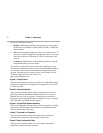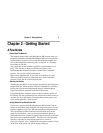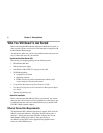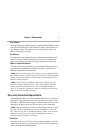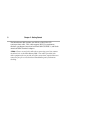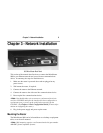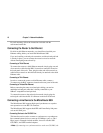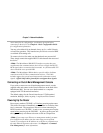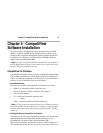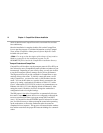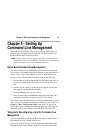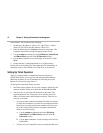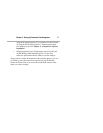
10 Chapter 3 - Network Installation
For wall mounting, follow the instructions included with the
wall-mount bracket kit.
Connecting the Router to the Ethernet
For thick or thin Ethernet networks, you should have installed your
Ethernet cabling before you install the MicroRouter 900i.
If you are installing a twisted-pair connection, and the twisted-pair hub
is already in place, you can connect the router to an active network
without interrupting network activity.
Connecting to Thick Ethernet
To connect the router to a thick Ethernet network, simply plug one end
of a transceiver cable into the DB-15 transceiver connector located on
the back panel of the unit. Then, plug the other end of the transceiver
cable into the transceiver which should already be attached to the thick
Ethernet cable.
Connecting to Thin Ethernet
In order to connect the router to a thin Ethernet cable, connect a
T-connector to the BNC connector located on the rear panel of the unit.
Connecting to Twisted-Pair Ethernet
Before connecting the router to twisted-pair cabling you need an
unshielded twisted-pair cable that is already connected to your
10BaseT-compatible twisted-pair hub.
To connect the router to the twisted-pair network, simply plug the
twisted-pair cable into the RJ-45 connector on the back of the unit.
Connecting a Line Device to the MicroRouter 900i
The MicroRouter 900i supports high-speed synchronous or asynchro-
nous operation over one RS-232 connector.
The MicroRouter 900i supports both PPP and Frame Relay link proto-
cols on this WAN port.
Connecting Devices to the RS-232C Port
This interface can be used to connect to synchronous or asynchronous
line communications devices at rates up to 256Kbps (sync), or 230.4
Kbps (async). Examples include modems, leased or switched 56K
CSU/DSUs, and ISDN terminal adapters.
v Note: If connecting to a synchronous device such as a CSU/DSU, the



